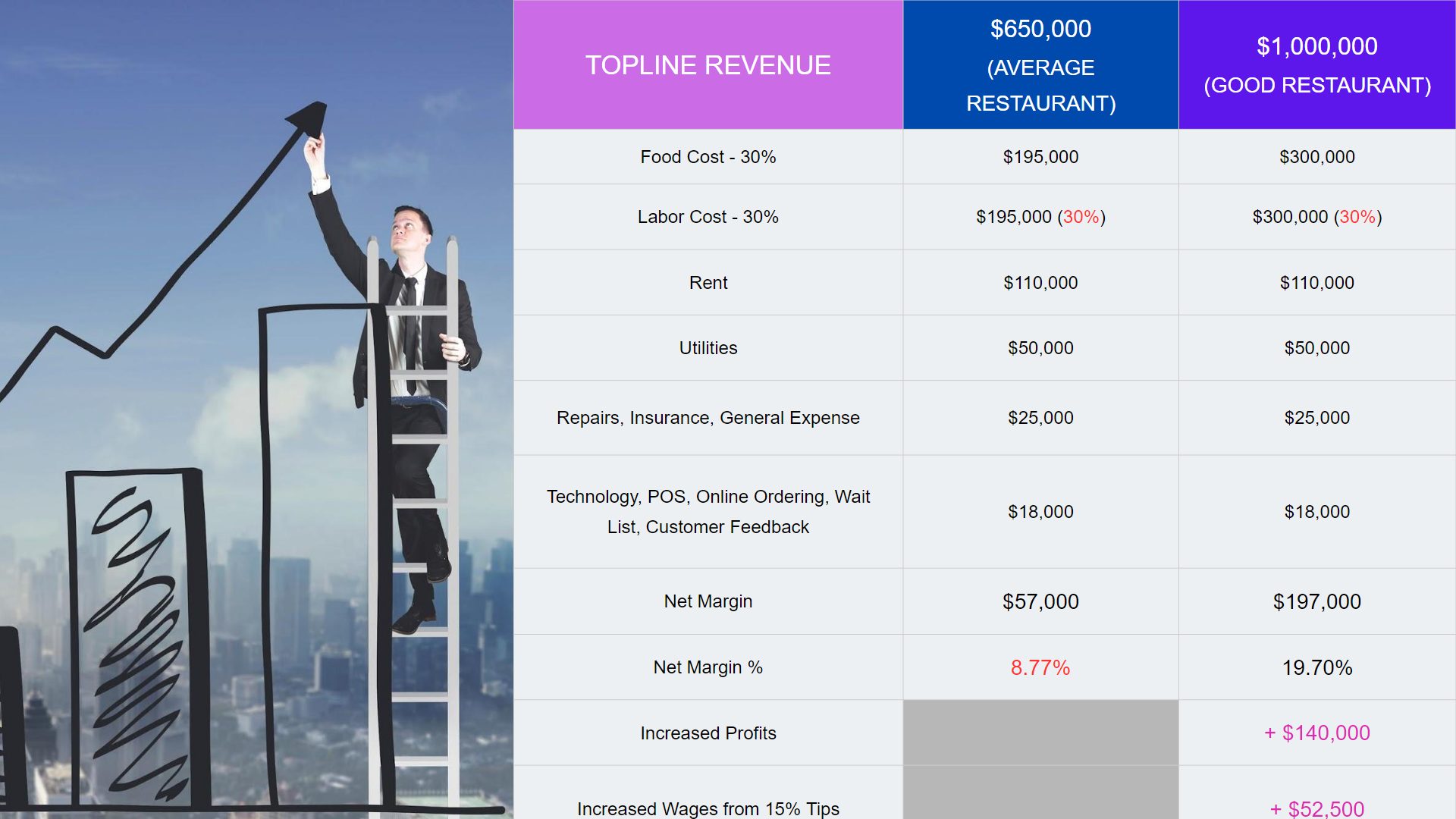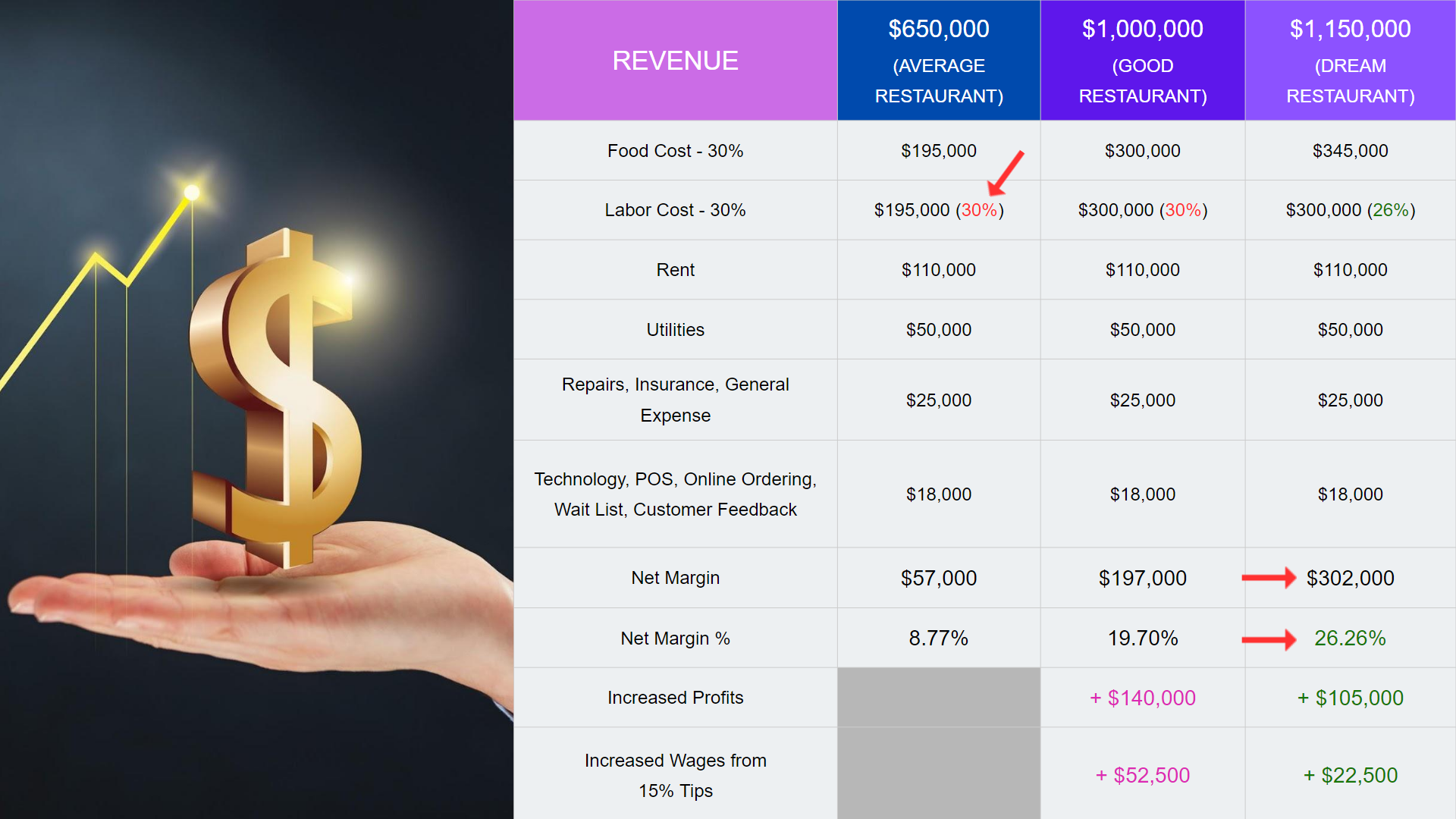Do you want to turn your restaurant into a thriving and profitable business? If so, you need to focus on one thing: top-line revenue.
According to the National Restaurant Association, the average profit margin for a restaurant is only 6%. That means for every $100 in sales, you only get to keep $6. And that’s before you factor in the costs of food, labor, rent, utilities, taxes, and technology.
In this article, we will explore how increasing top-line revenue can help you overcome these challenges and achieve long-term success.
The Thin Margin Challenge
Imagine you are running a busy lunch service, and suddenly your food supplier calls to tell you that the price of chicken has gone up by 20%. How do you adjust your menu and your budget to cope with this unexpected change? Or, imagine you are hiring a new chef, and you have to compete with dozens of other restaurants that offer higher wages and better benefits. How do you attract and retain the best talent for your kitchen?”
While most restaurant owners are barely breaking even, some are enjoying a steady stream of revenue and profits. What sets them apart? They have a strategic focus on increasing top-line revenue.
The Dream Scenario
What if you could run a restaurant that is always busy, always profitable, and always satisfying? What if you could have happy employees, loyal customers, and a positive reputation? What if you could have more time, more money, and more freedom to grow your business and enjoy your life?
This is not a pipe dream. It is a realistic and attainable goal. By focusing on increasing top-line revenue, you can transform your restaurant into a thriving and prosperous business that brings you joy and fulfillment.
The Impact on Profit Margins
The direct correlation between increased top-line revenue and enhanced profit margins is a critical relationship. A $150,000 boost in overall sales translates to an additional $105,000 in profits annually. With a 30% increase in profitability, the restaurant gains the financial resilience needed to withstand challenges like fluctuations in food costs and increased labor expenses. This strategic emphasis on revenue growth can be the key to unlocking a more profitable and sustainable business model.

Empowering Employees and Reducing Operational Costs
Beyond the impact on profit margins, a surge in top-line revenue directly benefits the backbone of any restaurant – its employees. An extra $22,500 in tips for servers, coupled with a 4% reduction in labor costs, empowers restaurant owners to invest in employee retention, offer attractive benefits, and create a positive work environment. This, in turn, contributes to reduced recruitment and training costs, fostering stability and operational efficiency.

A Breather for Restaurant Owners
Increased top-line revenue not only transforms the financial landscape of the restaurant but also provides a much-needed breather for owners. With the additional profits, owners can consider taking a well-deserved vacation, knowing that their business is thriving and financially secure. This newfound stability allows owners to focus on strategic planning, innovation, and the overall growth of their restaurant rather than constantly battling financial constraints.
The Role of Personalized Marketing
To achieve the dream scenario of a thriving restaurant, personalized marketing emerges as a powerful and transformative tool. By delivering the right message to the right customer at the right time through the right channel, personalized marketing becomes instrumental in driving customer retention. This, in turn, contributes to increased top-line revenue through more frequent visits, higher customer spending, and a stronger emotional connection between the restaurant and its patrons.
The intricate dance of personalized marketing involves understanding the diverse needs and preferences of the customer base. Imagine a scenario where families with children receive a “Kids Eat Free” promotion, or vegetarians are not bombarded with offers for premium steaks. Timing is crucial – targeting new guests, engaging those who haven’t visited in 30 days, and rewarding frequent visitors can significantly impact the success of marketing efforts.
The channels through which these personalized messages are delivered are equally important. Utilizing email, text messages and push notifications creates a multi-faceted approach that meets the customer where they are most comfortable. The right customer receives the right message at the right time through their preferred channel, creating a seamless and personalized experience that enhances customer satisfaction and loyalty.
Why is Personalized Marketing Important?
The significance of personalized marketing lies in its cost-effectiveness and high return on investment. It is 25 times cheaper to bring back an existing customer than to acquire a new one. Moreover, personalized marketing boasts a 6 times higher return on investment. These statistics underscore the importance of building and nurturing relationships with existing customers, ensuring their continued loyalty and patronage.
How to Personalize Marketing?
Embarking on the journey of personalized marketing involves a strategic four-step process:
1. Get the Customer’s Data
Utilize every interaction with the guest, from POS and online ordering to customer feedback, waitlists, gift cards, loyalty programs, and the website. Collecting comprehensive data is the foundation for personalized marketing. The richness of this data determines the effectiveness of subsequent marketing efforts.
2. Analyze the Data
Dive into the shopping behavior of every guest, understanding their frequency of visits, favorite items, lifetime value, birthdays, and more. This analysis provides valuable insights into customer preferences and habits. It forms the basis for crafting personalized messages that resonate with individual customers.
3. Understand the Opportunity/Set the Goal
Define the desired outcome and the behavior you want to influence. Whether it’s increasing the frequency of visits, promoting specific items, or celebrating special occasions with customers, having a clear goal guides your marketing efforts. This step ensures that each marketing campaign is purposeful and aligns with the overarching business objectives.
4. Meet the Guests Where They Are
Deliver the right message, at the right time, through the right channel, to the right customer. Tailor marketing efforts to match the preferences and characteristics of each guest. This requires a nuanced understanding of the diverse customer base and the ability to adapt marketing strategies accordingly.
Elevate Your Restaurant Business with More Topline Revenue
In the complex world of restaurant ownership, the importance of increasing top-line revenue cannot be overstated. By embracing strategies that focus on revenue growth, such as personalized marketing and integrated technology solutions, restaurant owners can not only overcome existing challenges but also pave the way for a thriving and financially secure future.
Elevating success begins with a strategic commitment to increasing top-line revenue. This involves creating a harmonious blend of customer-centric personalized marketing, efficient operational practices, and a resilient financial foundation. The dream of a bustling and prosperous restaurant becomes a lasting reality when the restaurant owner recognizes the transformative potential of increased top-line revenue and takes intentional steps to achieve it. The journey toward success is not only about navigating challenges but also about seizing opportunities for growth and creating a restaurant that stands the test of time.





